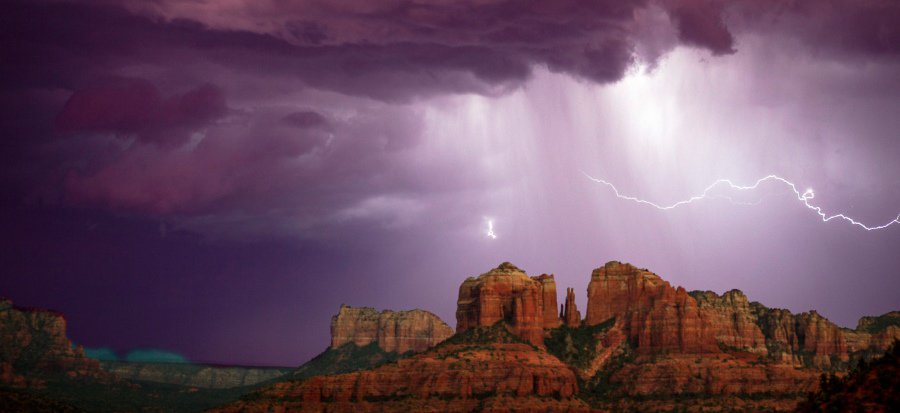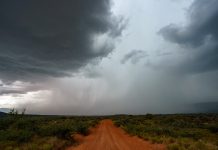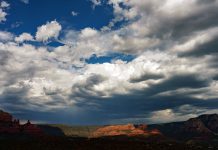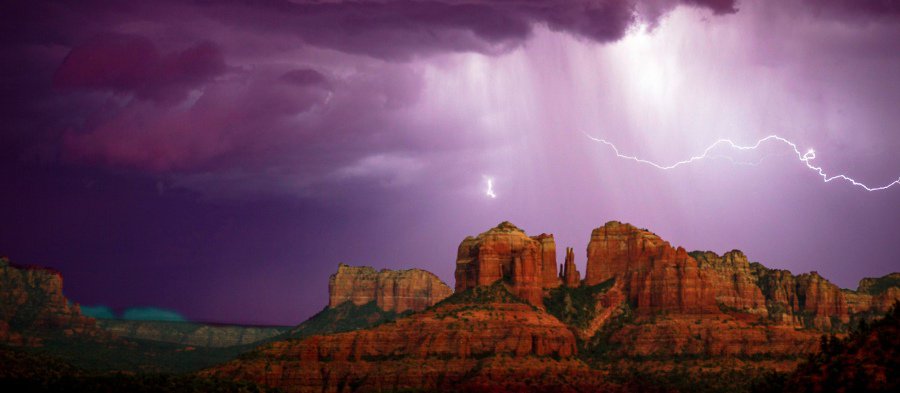Sedona residents watched the skies Wednesday, Aug. 28, anticipating that the massive buildup of gray and black clouds to the south and west meant we were due for a major monsoon thunderstorm by the end of the night. In the late evening, residents may even have seen the narrow downpour falling on the slopes of Mingus Mountain and assumed that such rainfall would fall in Sedona itself, only being a matter of time until dew points and barometric pressure aligned for the moisture to fall.
Residents throughout the valley took a second or two to shoot photos of the brilliant sunset painting these clouds in rose, gold and violet several thousand feet above us.
But as in weeks past, the clouds merely hung in the sky, taunting us below, before moving out or dissipating in the night.
The “nonsoon” monsoon has left our valley uncharacteristically dry this year, a major change from past years that saw microbursts and flash flooding all over our region and — from a newspaperman’s perspective — provided us with some great photos to present to our readers.
We have an excellent story by reporter Jon Hecht on Page 15A about why Arizona’s 2019 monsoon has been so lackluster and dry.
While the life-giving rains replenish Oak Creek, the Verde River and their tributaries and bring relief to the animal and human life in Arizona during the hottest parts of the calendar, the biggest immediate benefit of monsoon storms is that they extinguish summer wildfires.
Without a heavy downpour rolling through in June, July, August and September, the several lightning-caused wildfires burning in the Southwest continue to smoulder.
The Saber Fire northwest of Sedona atop the Mogollon Rim is now at more than 3,200 acres and about 58% contained. Crews are allowing the blaze to burn in a predetermined area of more than 12,000 acres. Without a storm to put a stop to that fire, it could, over the next several weeks, reach the containment lines and burn that entire acreage, all the while filling the skies above Sedona and the Verde Valley with smoke.
As winds shift, that smoke will drift toward our cities, spill over the rim and settle in the Verde Valley nightly, leaving us with the pungent campfire smell in the morning and causing respiratory problems with the very old, very young and those with pre-existing lung conditions.
Wednesday’s huge cloud buildup was ultimately for nought, as only parts of Cottonwood saw any rainfall and the clouds more or less passed us by.
The only real upside to a lack of thunderstorms is the lack of lightning that could set off more wildfires.
An electrical storm last year sparked so many small wildfires that the U.S. Forest Service gave up naming them after local landmarks and instead started naming them after animals in alphabetical order — hence why we got the Rhino and Platypus fires in the same location as the Saber Fire. Wild rhinoceroses are fairly rare in the Verde Valley and platypuses tend not to reach Sedona when migrating across eastern Australia.
The next month doesn’t look any more promising. Forecasters expect clouds of varying densities to build through Thursday, Sept. 12, but no thunderstorms are predicted.
Weather being a fickle thing, that forecast could change, and hopefully will, but as it stands now, we won’t have any thunderstorms between now and when the monsoon officially ends on Sunday, Sept. 15.
Christopher Fox Graham Managing Editor






















